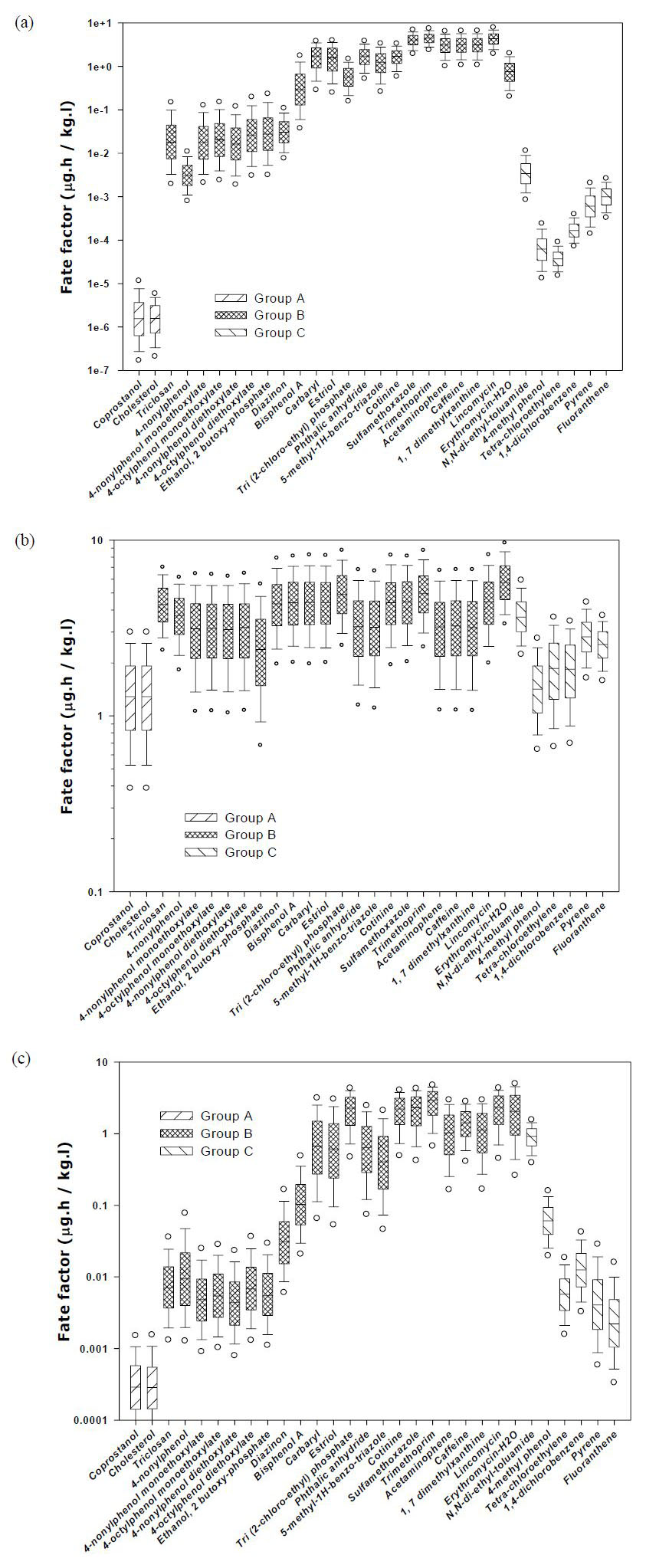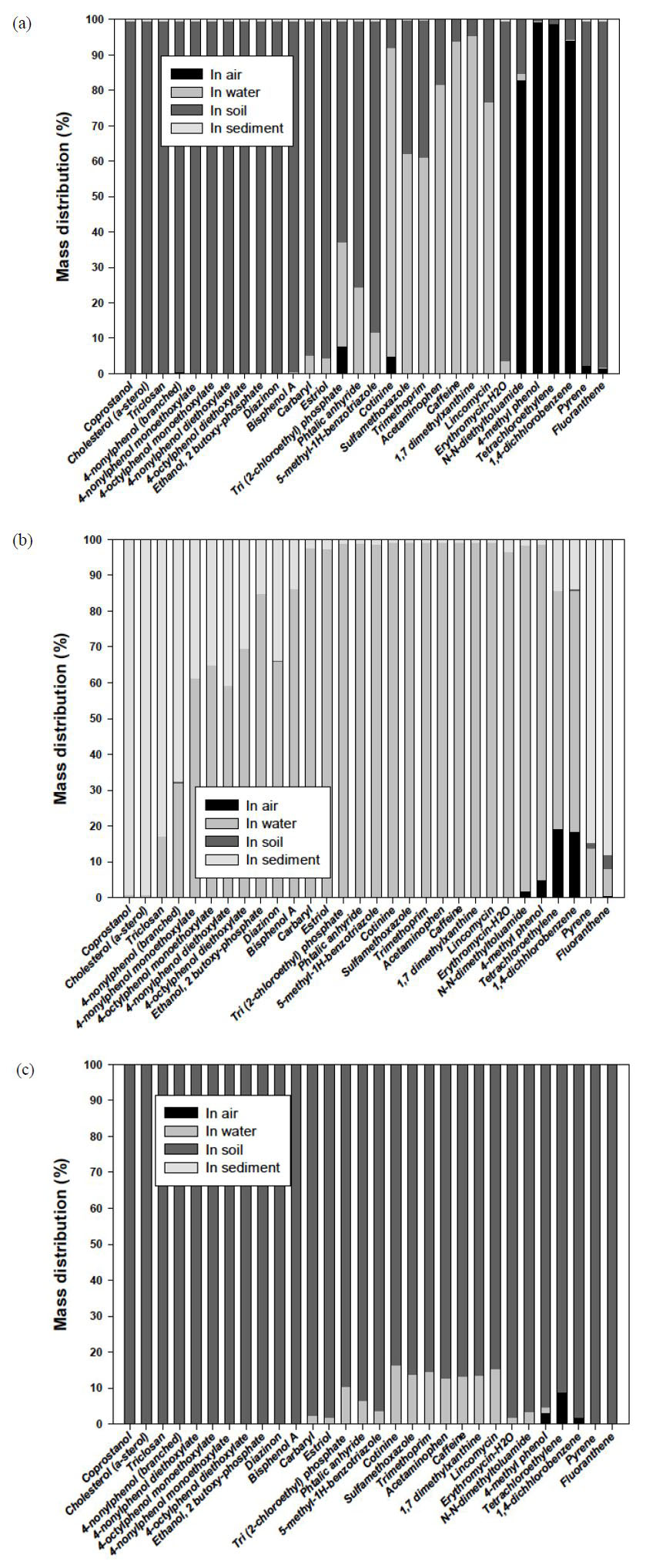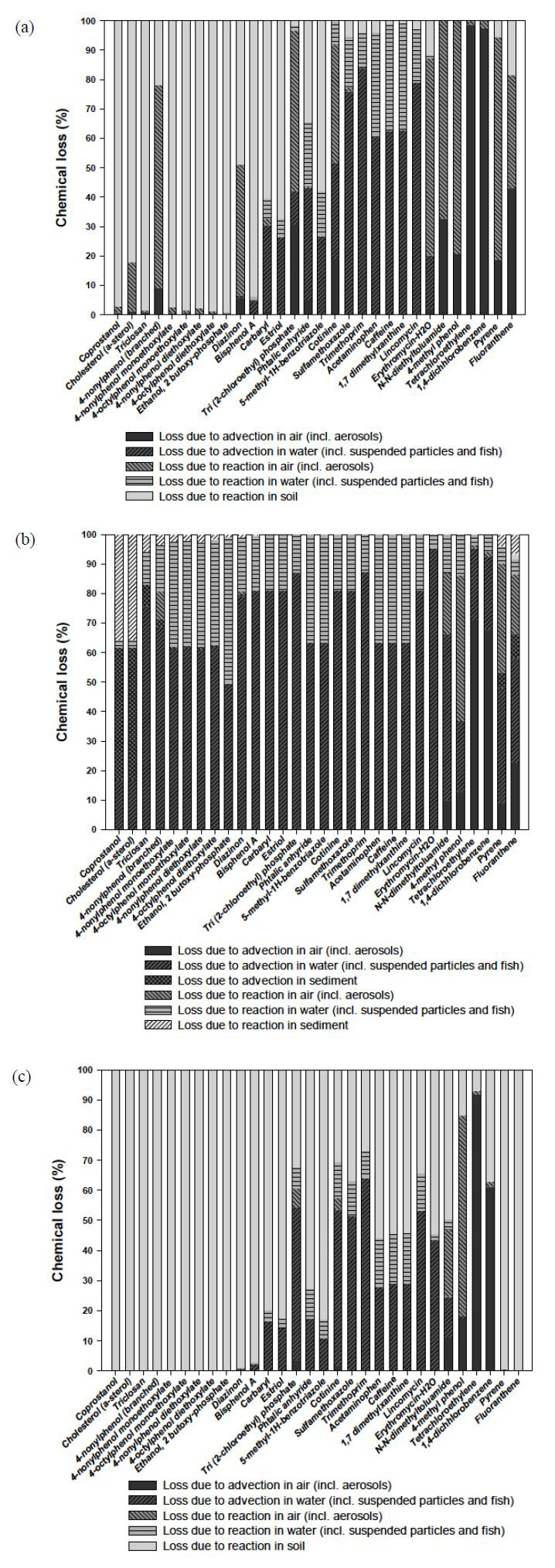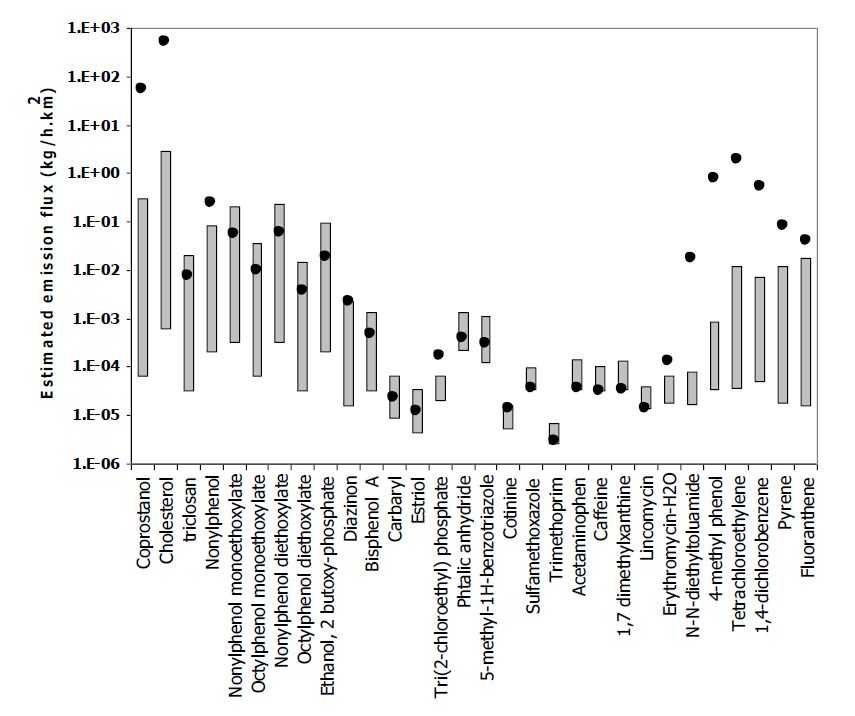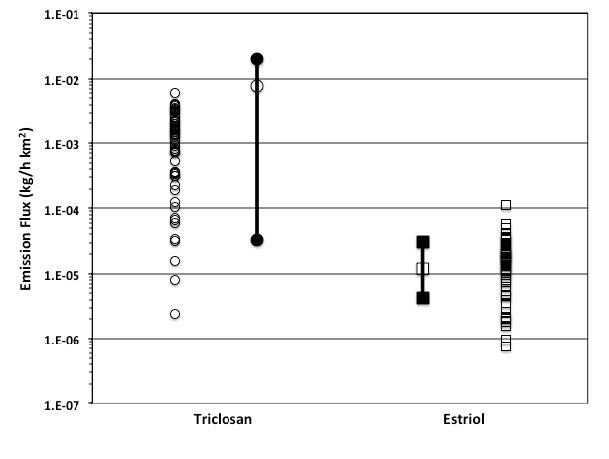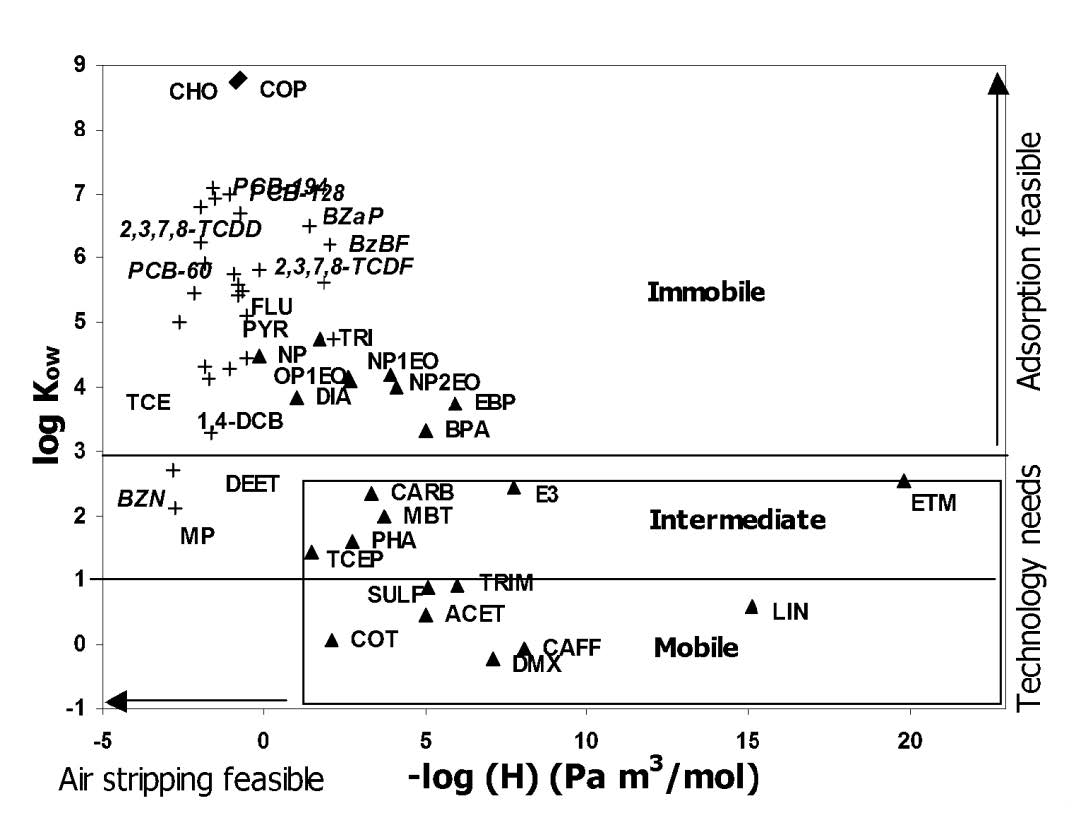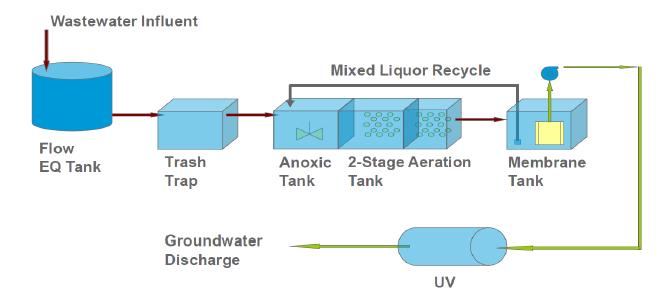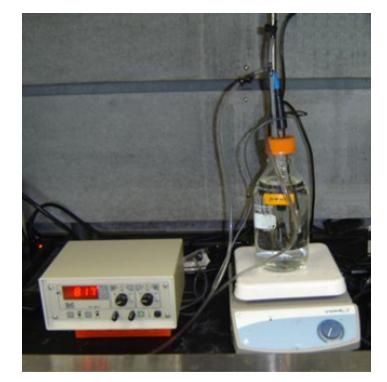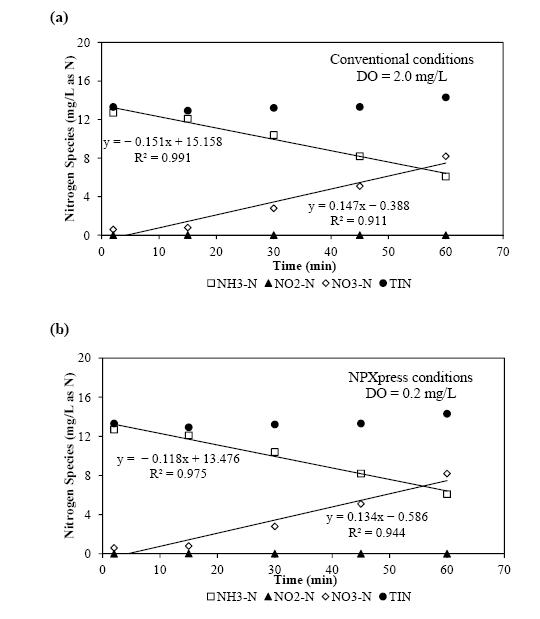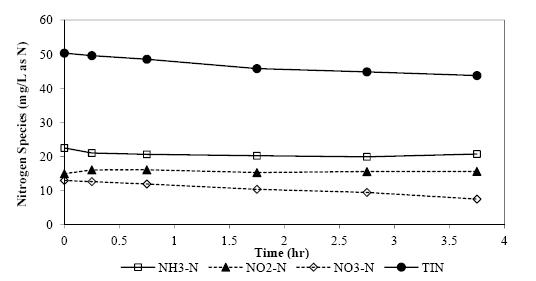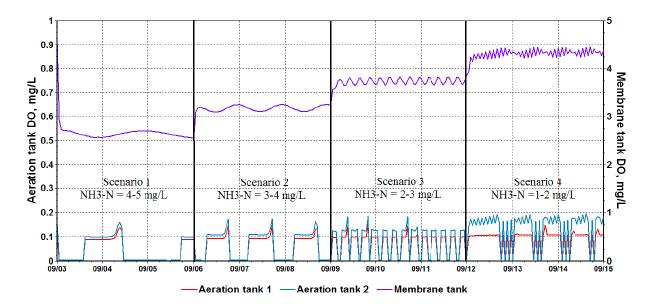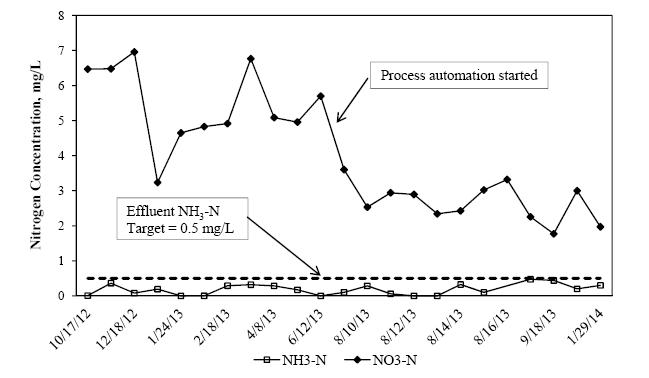1. Introduction
Many compounds found in pharmaceuticals, personal care products, hormones, and wastewater products are the subject of increasing research attention with respect to their environmental emissions, fate, and toxicity [1]. Due to analytical challenges associated with their structure and low concentrations [2,3], there have been only limited studies evaluating the fate of personal care products and pharmaceuticals in water resources [4,5,6]. The scope and potential impact of the problem on sustainable freshwater supplies is substantial, given the magnitude of their use and concerns about their environmental presence, including reproductive impairment [7,8], cancer incidence [9], and increased incidence of multiple antibiotic resistant bacteria [10]. Painkillers, antibiotics, contraceptives, beta-blockers, lipid regulators, tranquilizers, and impotence drugs are used worldwide in quantities similar to agrichemicals; yet, unlike many conventional priority pollutants, they represent a diverse spectrum of modes of action [1,11]. Municipal wastewater is considered one of the main discharge sources for emission of human pharmaceuticals into the environment, from excretion during a normal course of treatment or improper disposal of unused or expired drugs [12]. For assessment of exposure via inhalation, ingestion, and/or dermal contact to emerging contaminants of concern found in discarded pharmaceuticals, personal care products, and wastewater flows, fate and transport evaluations should consider the whole multimedia environment. This includes elements of the urban water cycle (source water, drinking water, wastewater influent and wastewater effluent) if emission is principally to surface waters, and food web analysis (e.g. exposure from agricultural produce) if emission is primarily to soil by land application of sludges.
The efficiency with which wastewater treatment plants (WWTPs) can remove pharmaceuticals is crucial to the reduction of human exposure and the ecological impact of these compounds. Due to their high polarity and linear sorption isotherms, many pharmaceuticals are only partially degraded or sorbed in WWTPs and in most cases will become prevalent in receiving waters and sediments [1,11,13,14]. Little is known about microbial degradation in treatment plants, but residence time is likely a controlling variable that may, for example, account for the lower concentrations of rapidly-degrading sulfamethoxazole and ibuprofen in the sludges of German wastewater treatment plants than the concentrations of more slowly degrading estradiol and roxithromycin [15]. Ternes [16] indicated removal efficiencies averaged about 60% for 14 pharmaceuticals, including those not observed in effluent (e.g., acetaminophen, salicyclic acid) and those that were hardly removed (e.g. carbamazepine). In bench-scale simulations, coagulation removed less than 25% of most pharmaceuticals, whereas chemical treatment (ozonation, chlorination) and sorption on activated carbon decreased soluble concentrations by as little as 10% to more than 95%.
Kolpin et al. [6] conducted the first nationwide reconnaissance of the occurrence of 158 compounds from a network of 139 streams, biased toward areas of intense urbanization and livestock production in the U.S. Among the compounds measured were 45 antibiotics, 12 prescription drugs, 8 non-prescription drugs, 14 hormones and steroids, and 79 household and industrial compounds, exhibiting a concentration range in water from 10-420 ng/L. Since receiving waters may serve as the source water for drinking water supplies, removal of these compounds, many of which are identified as emerging contaminants, by treatment processes such as coagulation, activated carbon sorption, and chemical disinfection is critical [3,17,18].
Considering the limited knowledge of release pathways of pharmaceuticals into the aquatic environment from sewage systems, and their likely persistence, there is a need to further develop models aimed at improving understanding of pharmaceutical fate in the environment. Fugacity-based multimedia environmental fate models [19] are widely used tools to understand and predict chemical fate in environmental media [20] and have been incorporated in life cycle assessment models for toxic releases [21,22,23]. Whereas fugacity models have mainly been applied to fate assessment of persistent organic pollutants (POPs) and Superfund-type chemicals [24,25], a few studies have applied these models to assess the fate of pharmaceuticals. For example, Di Guardo et al. [26] proposed a general strategy for how various generic and site-specific models of different complexity may be utilized to evaluate environmental fate of cyclophosamide, diazepam, and ivermectin. Khan and Ongerth [27] used a fugacity-based model to study the fate of pharmaceuticals subjected to sewage treatment. Zukowska et al. [28] applied a Level III multimedia model to polar organic chemicals by calculating environmental phase partitioning using poly-parameter linear free energy relationships. The model results were shown to be sensitive to the degradation rate in water and the equilibrium partitioning between organic carbon and water, suggesting that an accurate description of this particular partitioning equilibrium is important to obtain reliable predictions of environmental fate.
The estimation of the emission rates of emerging contaminants represents a major source of uncertainty for life cycle assessment and toxics release inventories. Hence, probabilistic approaches are warranted that incorporate sensitivity analysis for all input parameters or a first-order analytical uncertainty analysis such as that proposed by MacLeod et al. [29]. Hertwich et al. [30] used a Monte Carlo approach to estimate the potential dose for 236 chemicals grouped by exposure route. Reaction half-lives were found to contribute most of the variance, whereas landscape factors were assumed to be less significant, although Hollander et al. [31] have shown that landscape factors are also important in determining the fate of chemicals.
In this study, a fugacity-based analysis was carried out for the fate and transport modeling of the thirty most commonly detected compounds in U.S. streams [6]. The objectives of the study were to (i) classify the compounds based upon the parametric sensitivities of their predicted environmental concentrations, (ii) estimate the emission rates of the compounds into surface waters in the continental United States, and (iii) identify compounds that will need further consideration for using alternative methods to accomplish their removal from wastewaters received at treatment plants. To accomplish these objectives, the fugacity-based model was used to determine emission rate-independent fate factors that describe on a unit basis the distribution and fate of a compound released to the environment. When evaluated against measured surface water concentrations, the fate factors can thus be used to estimate the range of emission rates for emerging contaminants identified in surface waters.
2. Methodology
2.1. Physicochemical properties of the USGS 30 compounds
The physicochemical properties of the thirty compounds identified in the USGS national reconnaissance, hereafter referred to as the USGS 30 compounds, are summarized in Table S1 (see Supporting Information). Vapor pressures, water solubilities, degradation rate constants, and most melting points and octanol-water partition coefficients were estimated using EPIWIN [32]. Some melting points were estimated using Meissner’s method [33], and some octanol-water partition coefficients were collected from reported data [34,35,36]. A neutral stream pH of 7.0 was assumed. All of the USGS 30 compounds were modeled using their properties as neutral molecules, although it is recognized that some of the compounds are ionogenic, including the antibiotics triclosan, lincomycin, sulfamethoxazole, and trimethoprim.
An accurate description of partitioning between sorbent and water is needed if satisfactory results are to be obtained from the fugacity model. The most elaborate approach is to use poly-parameter linear free energy relationships (PP-LFERs) to represent partitioning between the sorbent and water phases in terms of a set of descriptors that include the excess molar refraction, the polarizability or dipolarizability, the overall solute hydrogen bond acidity and basicity, and the characteristic molecular volume [37]. A PP-LFER of this type with five linear free energy relationships yields six-parameter equations relating the fugacity capacities to the solute descriptors [28], and has been applied for the estimation of human intestinal adsorption of pharmaceuticals such as acetaminophen and erythromycin [38].
2.2. Chemical removal
Alternatively, a single-parameter linear free energy relationship (SP-LFER) can be used to calculate the sorbent phase fugacity capacity in terms of the octanol-water partition coefficient, Kow. Caution must be exercised in applying a SP-LPER based upon Kow to polar organic pharmaceuticals and wastewater compounds [39]. In this work, the use of the simpler SP-LFER approach is supported by two experimental studies of sorbent-water partitioning of pharmaceuticals and personal care products (PPCPs). Westerhoff et al. [40] investigated the removal of more than 60 endocrine-disrupting compounds (EDCs) and PPCPs from drinking water (including 11 of the USGS 30 compounds) using a variety of common water treatment methods, including chemical softening with lime and soda ash; aluminum sulfate or ferric chloride coagulation; addition of powdered activated carbon; and chlorine or ozone disinfection. In an 80-minute treatment period, they observed less than 25% removal for most (four-fifths) of the EDCs and PPCPs by partitioning onto coagulants or onto the inorganic metal hydroxide and carbonate precipitates formed by softening. Moreover, much of the observed removal of EDCs/PPCPs in the coagulation and softening processes was attributed to partitioning onto pre-existing suspended sediments in the spiked river water samples used for the testing. A 5 mg/L dose of powdered activated carbon (PAC), by contrast, was found to remove 50 to 95% of all but a handful of the EDC/PPCP compounds from water after 4 hours of contact time; by increasing the PAC dose to 20 mg/L, over 90% removal was obtained for all of 13 compounds except for ibuprofen (80% removal). Westerhoff et al. further observed that the percentage removal of EDCs/PPCPs on PAC is reasonably well correlated with log KOW.
In another reported study, Loffler et al. [41] estimated values for the sediment-water partition coefficient, KOC, and the solid-water distribution coefficient, Kd, values using KOW-based SP-LFERs for water-sediment partitioning of ten pharmaceuticals on a loamy sand with low organic carbon content (1.4 wt%). The predicted KOC and Kd values were in good agreement with experimental sorption measurements and other published data. Loffler et al. noted that the percentage removals of the pharmaceuticals from water over an extended period of 100 days were low (less than 25%) due to the low organic carbon content of the sediment. On the basis of these experimental observations of PPCP partitioning, it is presumed that the organic carbon content of soil and sediment is the component of the sorbent phase that is principally responsible for partitioning of USGS 30 compounds to these compartments; and moreover, that a SP-LFER relating KOC and KOW is acceptable to describe water-sediment partitioning of PPCPs in the environmental fate model. Recognizing that the continued development of group contribution methods for parameterization of PP-LFERs will yield increasingly accurate estimates for the phase partitioning properties of PPCPs, in the present work the scope of the environmental fate model is confined to a KOW-based SP-LFER for the sediment-water partitioning of the USGS 30 contaminants.
2.3. Landscape parameters and intermedia transport coefficients
The median surface water concentrations of the USGS 30 compounds, obtained from a national reconnaissance in the continental United States [6), form the data set for the analysis of emission fluxes. Although the sampling sites represent a wide range of geographies, hydrogeologies, climates, basin sizes and land use patterns, many of the water samples were collected at inland locations removed from large bodies of water such as lakes or oceans, in states such as Iowa, Nebraska, Oklahoma, and Missouri. Accordingly, Level II and III fugacity model equations were solved using Excel for a modified EQC (Equilibrium Criterion) model environment [25] representing a generic 1000 km2 region (typical of a county in the eastern United States) in which 1% of the surface is covered with water, a percentage commensurate with inland water areas reported by the U.S. Census Bureau [42] in the principal states comprising the USGS reconnaissance. The standard EQC model environment, by contrast, represents a 100,000 km2 region (comparable in area to the U.S. state of Ohio) with 10% water surface coverage.
The landscape parameters and intermedia transport coefficients used in the model are summarized in Table S2 [19,30,43]. The media and kinetic input parameters are the same as the default values generally used in the EQC model environment, except for the water compartment depth and the water advection residence time, which were both reduced per the characterization of the water compartment as fast-moving streams rather than larger bodies of water with longer residence times. For the selected water depth of 5 m, the corresponding water advection residence time was fitted to a mean stream flowrate obtained from data reported in the USGS national stream reconnaissance [44].
Fugacity capacities, or Z values, for the environmental media are summarized in Table S3. The fugacity capacity is the proportionality constant for the assumed linear relationship between the concentration and the fugacity of a compound. Similarly, for numerical convenience in fugacity modeling, D values are calculated that are coefficients representing transport, reaction, and intermedia transfer for the fugacities in the environmental compartments of the mass balance equations. Calculation details for the Z and D values are provided in the Supporting Information. The D values for chemical advection and degradation are reported in Table S4, and D values for intermedia transfer are tabulated in Table S5.
2.4. Fugacity calculations and uncertainty analysis
Level II and Level III fugacity model calculations were performed for an emission rate of 10 kg/h. This is a hundredfold reduction of the 1000 kg/h emission rate used in the standard EQC model, commensurate with the hundredfold reduction in the surface area of our county-sized model environment relative to the EQC standard environment. The Level II fugacity model assumes that the environmental compartments are in equilibrium with one another, whereas the Level III calculations assess chemical fate under nonequilibrium conditions. For the Level III model, the emission profile for chemical entry into the environment has a significant bearing on the chemical fate and distribution among the compartments. In this study, two modes of chemical emission are considered in the Level III modeling, one in which the emission occurs exclusively into the water compartment (hereafter referred to as the Level III-W model), and the other in which the emission is directed entirely into the soil compartment (the Level III-S model).
For each of the three models (Level II, III-W and III-S), the fate factor of each compound is reported as the predicted surface water concentration divided by the 10 kg/h emission rate. Reporting the fugacity model results in terms of the fate factor is preferable, because it provides an account of chemical fate that is independent of the magnitude of the chemical emission. By comparing the respective fate factors of the USGS 30 compounds, one can evaluate their relative propensities to accumulate in various environmental compartments, irrespective of the almost assuredly different emission rates of the compounds.
Crystal Ball (Decisioneering, Academic v.7) Monte Carlo simulation software was used to sample the variability of the predicted surface water concentrations to uncertainty in the model input parameters. Coefficients of variation (CVs) are reported in Tables S1 and S2 for assumed lognormal distributions of the physicochemical properties and landscape parameters. For most model parameters, the CVs recommended by Hertwich et al. [30] are used, so that input parameters of greater intrinsic uncertainty, such as degradation half-lives and mass transfer coefficients, are assigned larger CVs.
2.5. Emission flux estimates
From the measured surface water concentrations and the predicted surface water fate factors of each compound, the mean emission flux of each chemical into the local 1000 km2 environment at the 139 stream locations surveyed in the USGS reconnaissance was estimated. The ratio of the surface water concentration and the fate factor (for water concentration based on emission to water) yields an estimate of the emission flux as:
emission fluxwater = (concentrationwater)/[(fate factorwater-water)(surface area)]
This approach is similar to that suggested for the calculation of critical emission rates for risk assessment factors from objective and effect endpoint concentrations [45].
Because intermedia chemical transfer between the soil and water compartments is unidirectional, emissions originated in the soil compartment are readily transferred to surface waters via runoff, whereas emissions originating in water can only transfer to the soil compartment indirectly, by evaporation to air followed by deposition to the land surface. Consequently, emission fluxes computed for USGS 30 compounds from the Level III-S model are always larger than emission fluxes derived from the Level III-W model. Since the two models represent extremes in the modes of entry for these substances into the environment, the Level III-W and Level III-S fate factors are used to estimate lower and upper bounds respectively on the emission flux of each compound. For the latter model, the emission flux is effectively calculated as
emission fluxwater = (concentrationwater)/[(fate factorsoil-water)(surface area)]
= (concentrationwater)/[(transfer fractionsoil-water)(fate factorwater-water)(surface area)]
Direct emission to air is not regarded as significant for the USGS compounds, and so Level III calculations for emissions to air were not considered in this work.
3. Results
3.1. Partitioning behavior
The USGS 30 chemicals are represented within the context of their partitioning tendencies between air, water, and octanol in Figure 1 [46]. Abbreviations for compound names are listed in Table S1. Most compounds are concentrated in the bottom left or bottom center of Figure 1, where persistence is controlled by the degradation half-life in aqueous solution if emission to water is the principal release pathway. For compounds in the center or bottom center of Figure 1, significant partitioning may occur to multiple media under equilibrium conditions and environmental persistence is likely controlled by degradation in both water and organic media.
3.2. Surface water fate factors: emissions to water
Figure 2 shows the predicted fate factors of the USGS 30 compounds for the surface water compartment for the three different model scenarios. For the Level II calculation, the fate factors do not depend on the emission profile because of the assumption of interphase equilibrium, whereas for the Level III model, different fate factors are obtained for the water and soil emission pathways because equilibrium is not necessarily established between these compartments.
For the Level III-W model, a relatively homogeneous range of surface water fate factors is obtained for the USGS 30 compounds, ranging between 1.3 and 5.7 μg∙h/kg∙L. The fugacities (Table S6) computed for the Level III-W calculation indicate that the model system is far from equilibrium for all thirty compounds, with only the water and sediment compartments in near equilibrium. For the Level III-W results, the water-phase fugacity ranges from 1500 (tri (2-chloroethyl) phosphate) to 1014 (erythromycin-H2O) times larger than the soil-phase fugacity. Given the predisposition of many USGS 30 compounds to partition strongly to water (Figure 1), it is not surprising that a distinctly nonequilibrium steady-state condition is obtained when emission occurs only to the water compartment.
A sensitivity analysis was conducted to identify which model input parameters, when sampled individually over the ranges of uncertainty given by the assigned lognormal CVs, yield 5-95% confidence limits for the output surface water fate factor that depart by more than 15% at either endpoint from the mean (i.e. deterministic) surface water fate factor. The USGS 30 compounds can be divided into three groups from this analysis carried out at the Level III-W model description. The surface water fate factors of two compounds, coprostanol and cholesterol, are sensitive to three input parameters: the depth of the water compartment; the fraction of suspended particles in water; and the deposition velocity of suspended particles. These two compounds, labeled Group A in Figure 2, are readily distinguishable as the circled outlying pair with large KOW values in Figure 1. Because of their strong propensity to partition to organic-rich media such as suspended sediments, the surface water fate factors of the Group A substances are most heavily influenced by the availability of sorbent media in the water compartment and the rate at which these suspended media are removed from solution.
The surface water fate factors of a second subset of compounds, labeled Group B in Figure 2, are those most strongly affected by the assumed model parameter values for the water compartment depth and surface area, and the degradation half-lives of the compounds in water. The twenty-two compounds in this second, and largest, subset are those that tend to select strongly for the water compartment in the partitioning map of Figure 1. The surface water fate factors (Figure 2(b)) of the Group B compounds are among the highest of the thirty compounds on account of their resistance to transfer out of the water compartment. For Group B substances, variability in the predicted surface water fate factors is driven by uncertainties in the volume of the water compartment (relative to other compartments) and in the rates at which aqueous degradation occurs. For compounds that undergo acid-base speciation, the calculated surface water fate factor is expected to be larger if this effect is taken into account [47].
The remaining six compounds in Figure 2 comprise Group C: DEET (N, N-diethyltoluamide), 4-methyl phenol (p-cresol), 1,4-dichlorobenzene, tetrachloroethene, pyrene, and fluoranthene. The surface water fate factors of the Group C compounds are most sensitive to the water compartment depth and surface area; the degradation half-life in water (for DEET and 4-methyl phenol); and the water-side and air-side air-water mass transfer coefficients. The six Group C compounds exhibit the highest air-water partition coefficients (the encircled group near the top of Figure 1); consequently, volatilization of these compounds into air can significantly alter their predicted surface water fate factors.
3.3. Surface water fate factors: emissions to soil
If emission of USGS 30 contaminants to the environment occurs principally by land application of sludge as a fertilizer rather than by discharge of wastewater effluent, the surface water fate factors can be recalculated for the Level III-S model in which the emission enters the soil compartment rather than water. The results are shown in Figure 2(c), and it is evident upon comparison with Figure 2(b) that the surface water fate factors are always lower for USGS 30 compounds when emission occurs to soil rather than to water. In some cases, the difference in the fate factors for the Level III-W and Level III-S models is quite pronounced (note the different logarithmic scales of Figures 2(b) and 2(c)), most notably for the Group A and Group C compounds, where respective decreases in magnitude of 104 and 102-103 are observed for the surface water fate factors. The differences between the Level III-W and Level III-S fate factors for these groups can be attributed to the large octanol-water partition coefficients of the compounds in these categories. Likewise, log KOW > 4 for the subset of seven Group B compounds that have low surface water fate factors (< 0.01 μg∙h/kg∙L) when chemical emission is to soil rather than water. Ratios of Level III-W and Level III-S surface water concentrations approach parity for the more soluble and nonvolatile Group B compounds; for trimethoprim, for example, the Level III-W and Level III-S concentrations differ by less than a factor of 2 (4.91 and 2.92 μg∙h/kg∙L for emission to water and soil respectively). This can be attributed to the closer approach to soil-water equilibrium realized in the Level III-S model, as borne out by comparison of the fugacities reported in Table S6. The predicted surface water fate factors of half of the USGS 30
compounds are observed to be highly sensitive to the emission profile.
If the model calculation is carried out at the Level II description (Figure 2(a)) rather than at Level III, the surface water fate factors are reduced by a factor of 103 to 106 for the Group A and Group C compounds, relative to the Level III-W results. Given the nonequilibrium distribution of fugacities observed in the Level III-W model calculations, and the significant impediment to interphase transfer of USGS 30 chemicals from the water compartment to air and soil, the surface water fate factors predicted by the simpler Level II model (which has 31 input parameters, as opposed to 52 for Level III) must be regarded as suspect for compounds with large air-water or octanol-water partition coefficients.
3.4. Sediment fate factors
In Figure S1, the predicted sediment fate factors are shown for the USGS 30 compounds for the same three model scenarios as in Figure 2. As in the case of the surface water fate factors, the sediment fate factors depend strongly on the level of modeling implemented and the chemical emission pathway. The most extreme variations in the sediment fate factors of the USGS 30 compounds occur in the Level III-W model, where the predicted values range from <0.03 to >20,000 ng∙h/kg∙g solid, even though the Level III-W surface water fate factors of the compounds are tightly grouped (Figure 2(b)). If emission occurs to soil (Figure S1(c)), then the predicted sediment fate factors are more homogeneous across the set of USGS 30 compounds, due to the relatively short residence time for chemical transfer from soil to sediment by way of advection mechanisms involving the water compartment. Although the soil, water and sediment compartments are closer to equilibrium in the Level III-S model than in the Level III-W model, comparison to the Level II sediment fate factors (Figure S1(a)) suggests that significant reductions in the sediment fate factors of the volatile Group C compounds will occur if the chemical residence time in the system is extended to permit equilibration of the air compartment with the other compartments.
3.5. Air and soil fate factors
Table S7 summarizes the predicted air and soil fate factors of the USGS 30 compounds for the three models (for brevity, full boxplots of the air and soil fate factors of the USGS 30 compounds are not presented). For most of the compounds, the Level II calculations greatly overestimate the fate factors in air because, as shown in the Level III model calculations, equilibrium is rarely established between the air and water compartments. For the Level III-W model, near equivalence of the air and soil fugacities is attained, but the predicted air fate factors fall far short of the equilibrium Level II predictions because of slow evaporative chemical transfer from water to air for all but the most volatile compounds. For emission to soil (Level III-S), the Level II soil fate factors are within an order of magnitude of the Level III-S results for Group A and Group B compounds, but greatly underestimate the fate factors of the Group C compounds, which do not have sufficient time to establish air-soil equilibrium in the Level III-S model. Soil fate factors in the Level III-W model, meanwhile, are vastly lower for all compounds than in the Level III-S model, due to rate-limited chemical transfer of water-based emissions to soil by way of the atmosphere.
3.6. Mass distributions
The mass distributions of the USGS 30 compounds in the air, water, soil and sediment compartments are shown in Figure 3 for the three models. It should be noted that the results for the mass distribution are dependent upon the assumptions made regarding the respective volumes and physical properties of the environmental compartments. For the equilibrium (Level II) model, four Group C compounds partition principally to air; five Group B compounds partition principally to water; four other Group B compounds partition significantly to both water and soil; and the remaining seventeen compounds partition primarily to soil. When the equilibrium assumption is relaxed and the calculations are performed at the Level III model description, the mass distributions change dramatically. For the Level III-W model, an altogether different mass distribution emerges, with chemical mass residing principally in water for a majority of the compounds (19 of 30), and the sediment compartment serving as the principal reservoir for five other Group A and C compounds. The remaining six compounds, all from Group B, have a significant presence in both sediment and water.
For the Level III-S model, an overwhelming majority of the mass of all 30 compounds remains in the soil compartment, with only small amounts redistributed to water and air for the Group B compounds with the smallest KOW values and the Group C compounds with the largest air-water partition coefficients (KAW) respectively.
3.7. Chemical loss profiles
The chemical loss pathways for the USGS 30 compounds (Figure 4) are likewise profoundly influenced by the level of modeling implemented and by the assumed mode of chemical entry into the environment. Advection and reaction losses from the air compartment include losses from chemicals bound to aerosols; similarly, losses associated with chemical uptake into suspended sediments and fish are lumped into the advection and reaction losses for the water compartment. Since all three models assume steady-state conditions, the sum total of the rates of elimination of the compounds by the three advection outflows (air, water, sediment) and by degradation in all four compartments must equal the default emission rate of 10 kg/h.
For most of the compounds, the medium in which the bulk of elimination occurs is the compartment that serves as the principal reservoir in Figure 3. There are some exceptions: reactive losses in air, for example, are the principal loss mechanism for 4-nonylphenol and erythromycin-H2O in the Level II model, even though these two compounds partition almost exclusively to soil under equilibrium conditions. For the Level III-W model, water advection is the primary loss pathway and reaction in water the secondary loss pathway for all Group B compounds (for ethanol 2-butoxyphosphate, the two modes of elimination are about equal). Removal of Group A compounds in the Level III-W model occurs by advection and reaction in sediment, whereas Group C compounds are eliminated by a combination of air and water mechanisms. For all compounds except ethanol 2-butoxyphosphate and 4-methyl phenol, advection is the principal mode of chemical removal in the Level III-W environment. This differs markedly from the Level II results, where advection outstrips reactive losses for only nine of the 30 compounds. The differences can be ascribed to the greater uptake of USGS 30 compounds, in the equilibrium Level II model, into the non-advection soil compartment and into the air compartment, where chemical degradation occurs more rapidly (at least according to the EPIWIN parameterization) than in condensed phase media.
The chemical loss profiles obtained for the Level III-S model share more features with the Level II loss distributions than the Level III-W loss distributions. Degradation is the principal mode of chemical elimination from the Level III-S system, with advection serving as the primary loss pathway for only seven compounds. Soil-phase reactions are a principal loss mechanism in the Level III-S environment: a majority of chemical loss occurs via degradation for 21 compounds in the Level III-S model, as compared to 12 compounds in the Level II model.
3.8. Persistence
The overall persistence of the USGS 30 compounds in the county-sized fugacity model environment is shown in Figure S2 for the three models. Overall persistence is calculated as the total steady-state chemical mass in all compartments divided by the arbitrary emission (and total loss) rate of 10 kg/h. For this loading rate, the nonequilibrium Level III-W calculation predicts a persistence of 200 to 300 hours for most compounds. Eight species have persistence times exceeding 600 hours, and the two Group A compounds are the longest-lived. The latter is a consequence of the high predicted loadings of coprostanol and cholesterol onto stream sediments, where slow losses via advection and degradation are anticipated. For the Level III-S scenario (Figure S2(c)), the persistences of most Group B and Group C compounds are increased relative to the Level III-W model. This is explained in part by the role of the immobile soil compartment as a repository of chemical mass in the Level III-S environment. The persistence times computed in the Level II model broadly resemble those obtained for the Level III-S scenario, with the notable exception of the Group C compounds DEET, 4-methyl phenol, tetrachloroethylene, and 1,4-dichlorobenzene. Partitioning of these four compounds to air under equilibrium conditions leads to their rapid elimination by atmospheric advection and reaction and sharply reduced residence times in the Level II model.
4. Discussion
4.1. Emission flux estimates
To obtain quantitative agreement between the surface water concentrations of the USGS 30 compounds predicted by the Level III fugacity model and the concentrations measured in the USGS national reconnaissance, chemical-specific emission rates are required since a large variation is anticipated in the emission rates of wastewater organics [28]. The frequent occurrence of coprostanol and cholesterol in U.S. streams [6], for example, suggests that these two compounds may be released to municipal wastewaters in greater quantities than other USGS 30 substances. Indeed, coprostanol has been used as a sewage tracer due to its frequency of occurrence [48].
As noted in the methodology, from the measured surface water concentration and calculated surface water fate factor of each compound, the mean emission flux of each chemical into the local environment at stream locations surveyed in the USGS reconnaissance was estimated. For example, the median concentration of bisphenol A detected at USGS sampling sites is Cs = 0.14 μg/L [6]. The surface water fate factor predicted by the Level III-W model is 4.39 μg∙h/kg∙L. The ratio of the surface water concentration and the fate factor (for water concentration based on emission to water) yields an estimate of (0.14 μg/L)/(4.39 μg∙h/kg∙L)(1000 km2) = 3.2 × 10-5 kg/h km2 for the bisphenol A emission flux.
The bracketed emission fluxes obtained for USGS 30 compounds using this methodology are shown in Figure 5. For some Group B compounds, e.g. acetaminophen and caffeine, the estimated emission fluxes span a relatively narrow range because of close agreement in the surface water concentrations obtained using the two Level III models. However, for most compounds, the surface water fate factors of the Level III-W and Level III-S models are quite dissimilar, and so the projected emission fluxes span a much broader range: as much as three orders of magnitude for Group A and Group C compounds such as cholesterol and fluoranthene.
4.2. Comparison to emission fluxes from market data analysis
If chemical-specific emission profiles for a compound are known, the range of possible emission fluxes can be reduced significantly. Most USGS 30 compounds may be expected to enter the environment through a combination of treated wastewater discharge and land application of dewatered sludge as fertilizer. Median emission fluxes for USGS 30 chemicals will thus lie intermediate between the extremes given by the Level III-W and Level III-S results, since the principle of superposition applies to the linear algebraic set of Level III fugacity model equations. Moreover, if the total loading rate of a USGS 30 compound to the environment can be estimated by other meta-analyses (e.g., manufacturing data), useful insights on the emission profile of the compound, and its modes of entry into the environment, may be potentially obtained by comparing this loading to the range of fluxes projected for the compound in Figure 5.
As an example, Zhang et al. conducted multimedia fate analysis and emission estimates for the biocide triclosan [49] in the 58 river basins of China. Similar studies were reported by Zhang et al. for the fate and emission of 36 frequently detected antibiotic compounds [50] and for seven steroids [51], including the steroid estriol, into these basins. The triclosan emission rate in each basin was estimated from the population in the basin and from the average per capita Chinese consumption of personal care products [49]. Emissions of estriol and other steroids were estimated from excretions of humans and farm animals, the presumed main pollution sources, using human and animal populations reported in local statistical yearbooks for China’s administrative regions, and data for the treatment rate and removal efficiency of wastewater treatment plants [51].
From the reported triclosan and estriol emission rates, the corresponding emission fluxes into each river basin were obtained by dividing the emission rate by the basin area [49,51]. The emission fluxes so obtained are collectively plotted for each of the 58 river basins of China in Figure 6. Also shown, for comparison in Figure 6, are the emission flux estimates obtained for triclosan and estriol from application of the multimedia fugacity model to the USGS surface water concentration measurements.
For triclosan emission to the river basins of China, the mean and median emission fluxes for all 58 basins are 1.52 × 10−3 and 1.32 × 10−3 kg/h km2 respectively, with the lowest emission flux of 2.42 × 10−6 kg/h km2 obtained for the Senggecangbu basin in western China, and the highest emission flux of 6.12 × 10−3 kg/h km2 registered for the Taihu Lake basin in eastern China. Likewise, the minimum and maximum estriol fluxes of 7.46 × 10−7 and 1.12 × 10−4 kg/h km2 (obtained respectively for the Senggecangbu and the Tuhai-Majia River basins) bracket the mean and median emission fluxes into the basins of 1.86 × 10-5 and 1.54 × 10-5 kg/h km2 respectively calculated for this steroid.
Although the estimated emission fluxes vary over about three orders of magnitude for triclosan and two orders of magnitude for estriol in the 58 river basins of China, the scatter distribution of Figure 6 also shows that most of the emission fluxes are within the relatively narrow range of a single order of magnitude for both triclosan and estriol. For triclosan, 38 of the 58 basins have calculated emission fluxes between 5 × 10−4 and 5 × 10−3 kg/h km2. Similarly, for estriol, 45 of the 58 basins have emission fluxes between 4 × 10−6 and 4 × 10−5 kg/h km2.
As can be seen in Figure 6, the range of the triclosan and estriol emission fluxes predicted from the multimedia fugacity model align well with the most probable emission fluxes to China’s river basins as calculated for these compounds from market research data. Moreover, the fugacity model correctly predicts that the triclosan emission flux is about a hundredfold larger than that for estriol, and that triclosan has a larger range of projected emission fluxes than does estriol. Thus, the fugacity model predictions obtained from interpretation of the USGS data compare well both qualitatively and quantitatively with emission flux estimates obtained from the studies of the fate of personal care products and steroids in the river basins of China.
One obvious caveat for this comparison is the geographical mismatch of the emission fluxes obtained from market data analysis from river basins in China with fluxes estimated from the application of fugacity modeling to surface water concentration measurements in the U.S. Unfortunately, no emission estimates for geographical units in the U.S. were available for direct comparison to the fugacity model predictions. However, Zhang et al. note that the total usage of triclosan in personal care products in the U.S. is estimated to be three times greater than in China, and the per capita consumption of triclosan is 48 to 360% higher in Switzerland than in China [49]. Conversely, the predicted total excretions of steroids such as estriol in China are much higher than those reported for the European Union and the U.S., on account of the larger human and animal populations in China. Taking these differences into consideration, it follows that the mean emission flux for triclosan in U.S. river basins, for example, if estimated from market data in accordance with the procedures followed by Zhang et al., might be perhaps double or triple that shown in Figure 6 for river basins in China. Such a finding would not change the overall agreement between the emission flux estimates produced from the market analysis, and from the fluxes obtained from the multimedia model interpretation of the USGS reconnaissance data.
4.3. Implications for wastewater treatment
Because USGS 30 compounds have a propensity to partition to water, most of these substances are more mobile than volatile hydrophobic contaminants of historical interest to Superfund, denoted with crosses in Figure 7. This group of substances includes various PAHs, PCBs, dioxins and dibenzofurans. Removal by activated carbon adsorption may not be a feasible technology for capture of highly mobile USGS 30 compounds from wastewater, particularly Group B compounds with small KAW and KOW values. Indeed, Westerhoff et al. [39] demonstrated low removal efficiencies using powdered activated carbon for sulfamethoxazole, acetaminophen and trimethoprim. Chemical treatment by chlorination or ozonation, on the other hand, achieved >60% removal of these three compounds in simulated benchtop systems for drinking water treatment.
A further complication in the treatment of seven of the highly mobile USGS 30 compounds and six of intermediate mobility (i.e. those within the rectangle on the bottom right-hand side of Figure 7) is that the small Henry’s Law constant (i.e. low KAW) of these wastewater compounds impedes their capture from surface waters by air stripping. Given that the principal pathway for introduction of these substances into the environment is by emission into the urban water cycle, the resistance of Group B compounds to partitioning either to air or to sorbing media presents challenges in that treatment methods other than carbon-based adsorption or air stripping will have to be devised for their removal from wastewater prior, should such removal be deemed necessary. Ternes et al. [11] suggest post-treatment of biologically-treated wastewater using chemical or physical methods when ecotoxicological risks are substantial. Based upon phase equilibrium considerations, a significant number of the USGS 30 compounds that are emitted into soil at landfill sites will transfer into receiving waters, and eventually partition into sediments or biological media. The treatment obstacles identified in Figure 7 present future research challenges in the development of novel approaches for removal of emerging contaminants recognized to pose toxicological risk to humans or ecosystems.
As noted earlier, several of the USGS 30 compounds are ionogenic. In this study, the physicochemical properties of the compounds as neutral species were used in the analysis of their environmental fate and distribution. An activity-based approach to model the partitioning and transport of ionizing organics, as reported for ibuprofen and trimethoprim [52], would be a useful refinement to further improve the fugacity-based model presented here.
Because the USGS reconnaissance data were collected at geographically dispersed sampling locations, advective inflows of the USGS 30 compounds into the model environment were considered to be part of the total chemical emission into the environment. Resolution of chemical inflow into the respective portions that cross the model boundaries and that originate from emissions within the compartments would be possible with further analysis using spatially correlated surface water concentration datasets for the USGS 30 compounds, for example at sampling locations along streams traversing adjacent counties.
5. Conclusion
An emission and fate assessment of the thirty most frequently detected organic wastewater contaminants in U.S. streams and rivers, using Level II and Level III multimedia fugacity models for a 1000 km2 model environment, revealed that these thirty compounds may be categorized into three groups based upon the sensitivity of their predicted surface water fate factors to uncertainties in their physicochemical properties and in the fugacity model landscape parameters. The fate factors, mass distributions, and loss pathways of all of the USGS 30 compounds are strongly affected by their assumed modes of entry into the environment. Moreover, for thirteen of the USGS 30 compounds, conventional treatment strategies may be ineffective for their removal from wastewater effluents. Surface water fate factors predicted by the fugacity models were used in conjunction with the surface water concentrations measured in the USGS reconnaissance to obtain emission flux estimates for the compounds into U.S. streams and rivers. These include estimated fluxes of 6.8 × 10−5 to 0.30 kg/h km2 for the biomarker coprostanol; 1.7 × 10−5 to 6.5 × 10−5 kg/h km2 for the insect repellent N, N-diethyltoluamide; 2.6 × 10−6 to 4.4 × 10−6 kg/h km2 for the antibiotic trimethoprim; and 4.3 × 10−6 to 3.1 × 10−5 kg/h km2 for the steroid estriol.
Supplementary
A set of tables are provided in the Supporting Information that summarize the model input values for the chemical properties and landscape parameters, and the model output values for the compartment fugacities and D values for the various advection, reaction and interphase transport mechanisms. Figures reporting the sediment fate factors and overall persistence times predicted by the three fugacity models for the USGS 30 compounds are also included in the Supporting Information.
Acknowledgements
The Vietnam Education Foundation is acknowledged for fellowship support of H.T.T..
Conflict of interest
All authors declare no conflicts of interest in this paper.









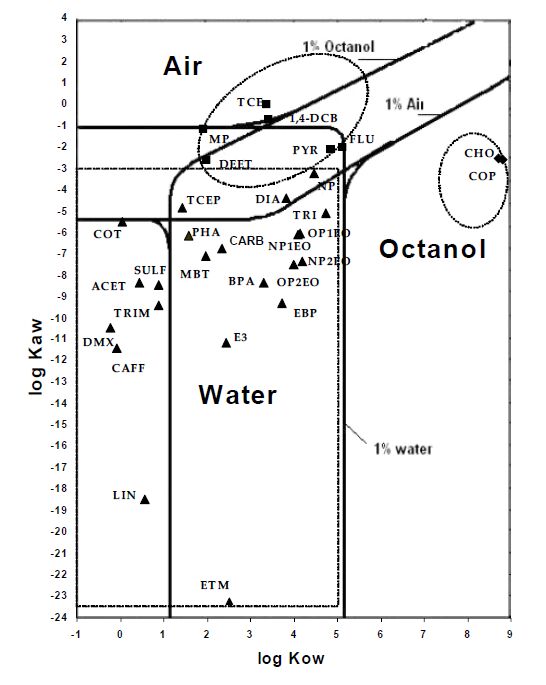
 DownLoad:
DownLoad: 